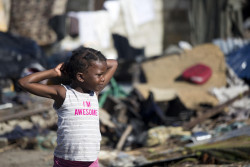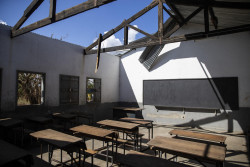 寄付方法のご案内
寄付方法のご案内
 ご寄付による支援例・成果
ご寄付による支援例・成果
 領収書
領収書
 その他のご協力方法
その他のご協力方法
 個人のみなさま
個人のみなさま
 学校・園のみなさま
学校・園のみなさま
 大学生ボランティア
大学生ボランティア
【2019年3月27日 ニューヨーク発】
南部アフリカに過去20年間で最悪の被害をもたらしたサイクロン「イダイ」の影響を受けた、マラウイ、モザンビーク、およびジンバブエの3カ国で緊急に人道支援を必要としている人は推定300万人にのぼり、その半数以上は子どもです。ユニセフ(国連児童基金)は本日、被災した3カ国において今後9カ月間、サイクロンによって打撃を受けた子どもたちと家族に人道支援を提供するために1億2,200万米ドルの資金が必要になると発表しました。
 |
|
© UNICEF/UN0291855/Prinsloo |
|
モザンビークの被災地で遊ぶ子ども。(2019年3月24日撮影) |
「サイクロン『イダイ』がもたらした大規模な被害が、日に日にあきらかになってきています」と、先週サイクロンの被害を受けたモザンビークのベイラを訪問したユニセフ(国連児童基金)事務局長ヘンリエッタ・フォアは述べました。「何百万人もの子どもたちと家族の命に危機が迫っています。私たちは直ちに、被災した3カ国に対して迅速かつ効果的な人道支援を提供する必要があります」
サイクロンの影響を受けたより多くの地域へのアクセスが可能となるにつれ、被災地の状況は改善し始める前に、さらに悪化することが予測されています。また、日和見感染症の拡大を防ぐための時間も極めて限られています。淀んだ水、不十分な衛生環境(トイレ)、死体の腐敗、過密した仮設住居といった現状は、下痢症、マラリア、およびコレラ集団感染を容易に引き起こす可能性があり、特に感染しやすいのは子どもたちです。モザンビーク当局は、ベイラですでに最初のコレラの症例が確認されたと発表しました。不衛生な環境下で避難生活を送る人々への広がりが懸念されています。
 |
|
© UNICEF/UN0292281/DE WET |
|
イダイの被害を受けたモザンビークの中学校。(2019年3月25日撮影) |
ユニセフはまた、過密した仮設住居で暮らし、暴力や搾取にあう危険がある女性と子どもの安全と健康を、また嵐で親を失った子どもや、家族とはなればなれになってしまった子どものことを深く憂慮しています。
最も影響を受けたモザンビークでは、子ども100万人を含む185万人が、切実に支援を必要としています。ベイラでは、インフラ施設が深刻な被害を受け、都市部は水が引かないために深く浸水したままです。収穫期直前の洪水により、モザンビークの例年の穀物生産量の50%までもが破壊されました。
マラウイでは、44万3,000人の子どもを含む、86万9,000人以上が影響を受け、8万5,000人以上が避難生活を余儀なくされています。
ジンバブエでは、27万人以上が影響を受け、その半数は子どもです。
ユニセフは3カ国において、影響を受けた子どもたちと家族への支援を強化し、保健ケア、水、衛生環境(トイレ)、教育などのサービスが受けられるようにするための活動をおこなっています。また、パートナー団体と共に、栄養不良増加の予防、家族を亡くしたり離ればなれになった子どもの特定、学校の再開などにも注力しています。
【関連ページ】
シェアする
